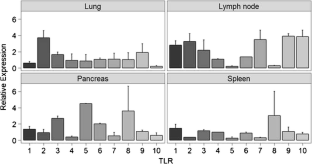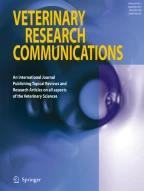Abstract
Previous research has shown that spotted hyenas (Crocuta crocuta) regularly survive exposure to deadly pathogens such as rabies, canine distemper virus, and anthrax, suggesting that they have robust immune defenses. Toll-like receptors (TLRs) recognize conserved molecular patterns and initiate a wide range of innate and adaptive immune responses. TLR genes are evolutionarily conserved, and assessing TLR expression in various tissues can provide insight into overall immunological organization and function. Studies of the hyena immune system have been minimal thus far due to the logistical and ethical challenges of sampling and preserving the immunological tissues of this and other long-lived, wild species. Tissue samples were opportunistically collected from captive hyenas humanely euthanized for a separate study. We developed primers to amplify partial sequences for TLRs 1–10, sequenced the amplicons, compared sequence identity to those in other mammals, and quantified TLR expression in lymph nodes, spleens, lungs, and pancreases. Results show that hyena TLR DNA and protein sequences are similar to TLRs in other mammals, and that TLRs 1–10 were expressed in all tissues tested. This information will be useful in the development of new assays to understand the interactions among the hyena immune system, pathogens, and the microbial communities that inhabit hyenas.

References
Abreu MT, Vora P, Faure E, Thomas LS, Arnold ET, Arditi M (2001) Decreased expression of toll-like receptor-4 and MD-2 correlates with intestinal epithelial cell protection against dysregulated proinflammatory gene expression in response to bacterial lipopolysaccharide. J Immunol 167:1609–1616
Altschul SF, Madden TL, Schäffer AA, Zhang J, Zhang Z, Miller W, Lipman DJ (1997) Gapped BLAST and PSI-BLAST: a new generation of protein database search programs. Nucleic Acids Res 25:3389–3402
Barton GM, Kagan JC (2009) A cell biological view of toll-like receptor function: regulation through compartmentalization. Nat Rev Immunol 9:535–542
Cameron JS, Alexopoulou L, Sloane JA, DiBernardo AB, Ma Y, Kosaras B, Flavell R, Strittmatter SM, Volpe J, Sidman R, Vartanian T (2007) Toll-like receptor 3 is a potent negative regulator of axonal growth in mammals. J Neurosci 27:13033–13041
Cowled C, Baker M, Tachedjian M, Zhou P, Bulach D, Wang LF (2011) Molecular characterisation of Toll-like receptors in the black flying fox Pteropus alecto. Dev Comp Immunol 35:7–18
Crozat K, Beutler B (2004) TLR7: A new sensor of viral infection. Proc Natl Acad Sci U S A 101:6835–6836
East ML, Hofer H, Cox JH, Wulle U, Wiik H, Pitra C (2001) Regular exposure to rabies virus and lack of symptomatic disease in Serengeti spotted hyenas. Proc Natl Acad Sci U S A 98:15026–15031
Engh AL, Funk SM, Horn RCV, Scribner KT, Bruford MW, Libants S, Szykman M, Smale L, Holekamp KE (2002) Reproductive skew among males in a female-dominated mammalian society. Behav Ecol 13:193–200
Flies AS, Grant CK, Mansfield LS, Smith EJ, Weldele ML, Holekamp KE (2012) Development of a hyena immunology toolbox. Vet Immunol Immunopathol 145:110–119
Franchini M, Zini E, Osto M, Jablonski K, Kaufmann K, Lutz TA, Reusch CE, Ackermann M (2010) Feline pancreatic islet-like clusters and insulin producing cells express functional Toll-like receptors (TLRs). Vet Immunol Immunopathol 138:70–78
Harrison TM, Mazet JK, Holekamp KE, Dubovi E, Engh AL, Nelson K, Van Horn RC, Munson L (2004) Antibodies to canine and feline viruses in spotted hyenas (Crocuta crocuta) in the Masai, Mara National Reserve. J Wildl Dis 40:1–10
Ignacio G, Nordone S, Howard KE, Dean GA (2005) Toll-like receptor expression in feline lymphoid tissues. Vet Immunol Immunopathol 106:229–237
Knudsen B, Knudsen T, Flensborg M, Sandmann H, Heltzen M, Andersen A, Dickenson M, Bardram J, Steffensen PJ, Mønsted S, Lauritzen T, Forsberg R, Thanbichler A, Bendtsen JD, Görlitz L, Rasmussen J, Tordrup D, Værum M, Ravn MN, Hachenberg C, Fisker E, Dekker P, de Meza J, Hein A-MK, Sinding JB, Quorning J, Hvam K, Mikkelsen S, Liboriussen P, Grydholt J, Handberg H, Bundgaard M, Joecker A, Simonsen M, Nielsen PRL, Joecker A, Fleischer P, Jakobsen J, Juul S, Appelt U, Fejes A, Christensen AS (2012) CLC Sequence Viewer, 6.7.1 ed. CLC bio
Lembo T, Hampson K, Auty H, Beesley CA, Bessell P, Packer C, Halliday J, Fyumagwa R, Hoare R, Ernest E, Mentzel C, Mlengeya T, Stamey K, Wilkins PP, Cleaveland S (2011) Serologic surveillance of anthrax in the Serengeti ecosystem, Tanzania, 1996–2009. Emerg Infect Dis 17:387–394
Livak KJ, Schmittgen TD (2001) Analysis of relative gene expression data using real-time quantitative PCR and the 2−ΔΔCt method. Methods 25:402–408
Medzhitov R, Schneider DS, Soares MP (2012) Disease tolerance as a defense strategy. Science 335:936–941
Ménager P, Roux P, Mégret F, Bourgeois J-P, Le Sourd A-M, Danckaert A, Lafage M, Préhaud C, Lafon M (2009) Toll-like receptor 3 (TLR3) plays a major role in the formation of rabies virus negri bodies. PLoS Pathog 5:e1000315
Mercier E, Peters IR, Day MJ, Clercx C, Peeters D (2012) Toll- and NOD-like receptor mRNA expression in canine sino-nasal aspergillosis and idiopathic lymphoplasmacytic rhinitis. Vet Immunol Immunopathol 145:618–624
Nomura F, Akashi S, Sakao Y, Sato S, Kawai T, Matsumoto M, Nakanishi K, Kimoto M, Miyake K, Takeda K, Akira S (2000) Cutting edge: endotoxin tolerance in mouse peritoneal macrophages correlates with down-regulation of surface toll-like receptor 4 expression. J Immunol 164:3476–3479
Opal S, Huber C (2002) Bench-to-bedside review: toll-like receptors and their role in septic shock. Critical Care 6:125–136
Penning LC, Vrieling HE, Brinkhof B, Riemers FM, Rothuizen J, Rutteman GR, Hazewinkel HAW (2007) A validation of 10 feline reference genes for gene expression measurements in snap-frozen tissues. Vet Immunol Immunopathol 120:212–222
Raja A, Vignesh AR, Mary BA, Tirumurugaan KG, Raj GD, Kataria R, Mishra BP, Kumanan K (2011) Sequence analysis of Toll-like receptor genes 1-10 of goat (Capra hircus). Vet Immunol Immunopathol 140:252–258
Roach J, Glusman G, Rowen L, Kaur A, Purcell M, Smith K, Hood L, Aderem A (2005) The evolution of vertebrate toll-like receptors. Proc Natl Acad Sci U S A 102:9577–9582
Schneider DS, Ayres JS (2008) Two ways to survive infection: what resistance and tolerance can teach us about treating infectious diseases. Nat Rev Immunol 8:889–895
Siegemund S, Sauer K (2012) Balancing pro- and anti-inflammatory TLR4 signaling. Nat Immunol 13:1031–1033
Theis KR, Venkataraman A, Dycus JA, Koonter KD, Schmitt-Matzen EN, Wagner AP, Holekamp KE, Schmidt TM (2013) Symbiotic bacteria appear to mediate hyena social odors. Proc Nat Acad Sci 110:19832–19837
Van Horn RC, Engh AL, Scribner KT, Funk SM, Holekamp KE (2004) Behavioural structuring of relatedness in the spotted hyena (Crocuta crocuta) suggests direct fitness benefits of clan-level cooperation. Mol Ecol 13:449–458
Acknowledgements
We would like to thank the Dr. Stephen E. Glickman and the staff of the Field Station for Behavioral Research at UC Berkeley for their assistance with tissue collection from the captive hyenas, Dr. Julia Bell for her advice on laboratory procedures, and Dr. Barry Williams for his comments on the research. This work was supported by Award No. W911NF-08-1-0310 from the Army Research Office and NSF Grants IOS1121474 and IOS0819437 to KEH, NSF Grant IOS0809914 to SEG, NIH grant K26RR023080 to LSM, grants-in-aid-of research from Sigma Xi and the American Society of Mammalogists to ASF, veterinary student scholars program from the Morris Animal Foundation, and a NSF Graduate Research Fellowship to ASF.
Author information
Authors and Affiliations
Corresponding author
Rights and permissions
About this article
Cite this article
Flies, A.S., Maksimoski, M.T., Mansfield, L.S. et al. Characterization of toll-like receptors 1–10 in spotted hyenas. Vet Res Commun 38, 165–170 (2014). https://doi.org/10.1007/s11259-014-9592-3
Accepted:
Published:
Issue date:
DOI: https://doi.org/10.1007/s11259-014-9592-3

